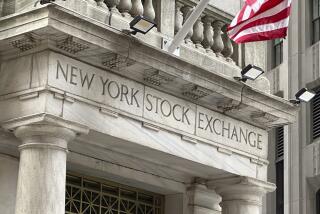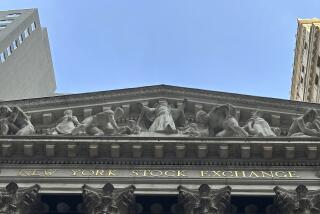Stocks of Many Firms Blossomed in 1989, While Others’ Wilted Badly : Securities: Investors made a killing in companies that turned hot. But those who put money into ailing financial firms got burned.
Jordan Friedman didn’t pour over financial data when he decided to invest $450 in shares of L.A. Gear. He looked at people’s feet. The 18-year-old college freshman said all the girls he knew in high school wore the company’s shoes, and he thought that the stock would take off as a consequence.
Friedman couldn’t have been more right. L.A. Gear, a Los Angeles-based maker of casual clothing and shoes, was one of the nation’s hottest stocks in 1989. Spurred by marketing coups such as securing pop star Michael Jackson to pitch its products and by strong demand for the company’s athletic shoes, L.A. Gear’s share price more than tripled during the year, closing at $33.125, up 186.2%. The gain would have been even greater had the stock not tumbled after the market drop last October.
L.A. Gear was only one of several New York Stock Exchange companies that allowed investors to make a killing during 1989. People who poured money into specialized retailers, such as Claire’s Stores, drug and oil companies also reaped substantial rewards.
However, many other investors got pounded in the market after putting their money into troubled financial institutions and money-losing or debt-strapped firms of all types.
The big losers included two financial institutions--Crossland Savings Bank of Brooklyn, N.Y., and Citytrust Bancorp of Bridgeport, Conn.--along with computer companies, including Prime Computer and MAI Basic Four of Tustin, and a wide variety of overextended firms in everything from health care to convenience stores.
The problems that these companies faced were relatively straightforward. Crossland and Citytrust found their real estate portfolios souring in late 1989, prompting each to set aside large reserves for loan losses.
And although they don’t show up as the biggest losers on the New York exchange, a number of other financial and real estate companies also lost a substantial portion of their market values in 1989 because of declining real estate values and other industrywide problems.
Among these: Columbia Savings, which is struggling with a huge portfolio of junk bonds; Bank of New England, which recently boosted reserves for loan losses; Lomas & Nettleton Mortgage, a real estate investment trust; RAC Mortgage, and Emerald Mortgage.
National Education faced a series of problems that started with its purchase of another training company two years ago. The acquired company, which specialized in computer training, tried to expand too fast, driving away both profits and customers, said Fred Anschel, vice president and analyst at Dean Witter Reynolds in New York.
Several management changes implemented by National Education proved futile, and a revolving door in the executive suite created an image of instability at the Irvine-based firm. Now things are beginning to look better, Anschel said, but he’s still not recommending the stock. “There is still considerable risk,” he said.
Meanwhile, a much ballyhooed merger between Comprehensive Care and First Hospital Corp. was derailed in late 1989 by bankers who refused to finance the deal. Comprehensive, which was already suffering from a steep decline in profitability, saw its stock drop as a consequence.
And some others were hard hit by industry woes, such as a slowdown in the computer industry, which hurt both MAI Basic Four and Prime Computer.
Wall Street’s biggest winners were a much more diverse lot.
Besides L.A. Gear, these companies included Mylan Laboratories, a Pittsburgh-based generic drug company; Claire’s Stores, which operates 700 costume jewelry and accessory outlets; Shaw Industries, a Dalton, Ga., housewares firm; and Eli Lilly, an Indianapolis-based prescription drug firm. These companies recorded market gains of between 100% and 200% during 1989.
The key to their success?
Some companies simply exceeded expectations for earnings and market share growth, catapulting them into the arena of stock market stars. One, Holiday Corp., sold off its Holiday Inn division and paid a special dividend to shareholders. Others came up with breakthrough products, greatly increasing the company’s potential. And then, several were turnaround stories.
Claire’s Stores is one such example.
The Miami-based jewelry and accessory retailer was overstocked in 1988, which forced heavy discounting at many of its 700 outlets, said Chris Vroom, retail analyst with Alex. Brown & Sons in Baltimore.
However, demand for its products remained strong. So once the company started keeping better control of inventory, it was set for fast growth, Vroom said. The company also has established direct contact with many of its suppliers, giving it better-than-average control over the design and quality of products sold in their stores.
Vroom is confident this growth will continue, making Claire’s a good investment well into 1990, he said.
“They have the best momentum of any of the companies I follow,” he added. “The (stock) market’s perception of them has been negative in the past because they’ve stumbled. But I think, after they report next quarter’s earnings, that perception will change, and that will lead to more (stock price) expansion.”
For L.A. Gear, the key to success was surprising the analysts. In years past, market watchers had thought L.A. Gear, which started out making women’s casual shoes, might be a flash-in-the-pan--a trendy company whose products would fade away like pet rocks and bell-bottom jeans. But after several years of steady growth, the analysts changed their tune. The company expects to maintain the momentum by its diversification into men’s athletic shoes and clothing. But at current prices analysts are not as bullish.
Holiday Corp. was also not a company that wowed investors--until it announced the sale of its trademark operation, the Holiday Inn hotel chain. Then the company, which was selling for roughly $35 a share, announced that it would distribute the proceeds of the sale to shareholders through a special $30-a-share dividend.
Holiday, which also owns casinos and hotel chains such as Embassy Suites and Hampton Inns, will change its name to Promus Cos. after the Holiday Inn sale is completed. Then it plans to look for a buyer for its casinos, said Daniel Lee, a leisure analyst with Drexel Burnham Lambert in New York.
Mylan Laboratories, on the other hand, has been a consistent performer, said Robert Kanters, senior vice president of research at Legg Mason Masten Inc. in Pittsburgh.
“They have had a remarkable performance over the past 10 to 15 years,” Kanters said. The Pittsburgh-based company produces generic drugs--lower-priced competitors to brand-name medicines whose patents have expired. And Mylan, for years, has been quietly clicking out steady gains in sales and earnings.
But the company recently decided to start developing some drugs of its own. And that has been the major reason for the surge in its stock price during 1989, Kanters said. In a joint venture with another company, Mylan has developed a drug called Eldepryl, which is believed to have good potential for treating Parkinson’s disease. Industry experts believe that the market for this drug could reach $100 million--about equal to Mylan’s current annual sales.
Still, at current prices, Kanters said he is no longer bullish about the stock.
“This is a long-term investment at this price because its trading at 50 times earnings,” he said. “People are not looking at this year’s earnings, or even next year’s. They are speculating on what may be a blockbuster drug.”
TOP 10 NEW YORK EXCHANGE WINNERS
List includes only common stocks and reflects stock splits and dividends. Not included are stocks whose 1989 closing price was below $2.
Close ($) Yr. to date Stock Dec. 29, ’89 % change Line of business L.A. Gear 31.125 +186.2 Makes and markets footwear and apparel Claire’s Stores 13.625 +179.5 Jewelry and accessory retailer Mylan Laboratories 24.25 +173.2 Generic pharmaceuticals Holiday Corp. 71.75 +165.7 Hotel and casino company Shaw Industries 31.00 +163.8 Carpet manufacturer Eli Lilly 62.375 +152.0 Prescription drugs and medical equipment Baroid Corp. 11.25 +150.0 Oil and gas products supplier Pogo Producing 10.25 +148.5 Independent oil and gas producer Galveston-Houston 5.875 +147.4 Mining and construction products Varco 7.25 +141.7 Drilling equipment manufacturer Source: Associated Press
TOP 10 NEW YORK EXCHANGE LOSERS
List includes only common stocks and reflects stock splits and dividends. Not included are stocks whose 1989 closing price was below $2.
Close ($) Yr. to date Stock Dec. 29, ’89 % change Line of business Crossland 3.375 -80.6 Savings and loan Savings Rexene 3.50 -76.5 Plastic products manufacturer National 6.875 -70.4 Vocational training Education programs Circle K 3.375 -70.3 Convenience stores Comprehensive 2.875 -66.2 Chemical dependency Care programs MAI Basic 2.875 -66.2 Computer systems Four for small businesses Citytrust 13.25 -65.2 Bank holding Bancorp company Artra 10.375 -64.5 Jewelry and food Group packaging Prime 6.375 -63.6 Makes and markets Computer computer systems Tucson 18.00 -63.6 Utility Electric
Source: Associated Press
TOP 10 OVER-THE-COUNTER WINNERS
List includes only common stocks and reflects stock splits and dividends. Not included are stocks whose 1989 closing price was below $2.
Close ($) Yr. to date Stock Dec. 29, ’89 % change Line of business QSR 4.5 +2,400.0 Retail food service Psychemedics 5.0625 +800.0 Physicians’ offices HMO America 7.625 +713.3 Health maintenance organizations OSHAP Technologies 4.125 +560.0 Special industry machinery Barton Industries 4.875 +550.0 Valves and chokes; oil and gas Energy Ventures 51.5 +543.8 Oil and gas Sono-Tek 5.25 +500.0 Electrical industrial apparatus EMS Systems 2.00 +433.3 Manufactures electronic parts Kentucky Medical Ins. 19.25 +431.0 Insurance carrier American Integrity 6.25 +426.3 Supp. accident, life insurance
Source: Associated Press
TOP 10 OVER-THE-COUNTER LOSERS
List includes only common stocks and reflects stock splits and dividends. Not included are stocks whose 1989 closing price was below $2.
Close ($) Yr. to date Stock Dec. 29, ’89 % change Line of business Amerifirst Bank 2.25 -87.8 Savings and loan General Real Estate 2.00 -84.6 Real estate development Central Banking Sys. 2.00 -83.2 Bank holding company Eliot Savings Bank 2.00 -78.1 Commercial savings bank Numerica Financial 2.00 -77.8 Bank holding company Campeau 3.00 -77.6 Owns department store chains Tele-Art 2.125 -77.3 Watches and clocks Nu-West Industries 3.25 -77.2 Agricultural chemicals New Hamp. Saving Bank 2.5 -76.7 Commercial savings bank Valley Federal S&L; 3.125 -76.4 Savings and loan
Source: Associated Press
TOP 10 AMERICAN EXCHANGE WINNERS
List includes only common stocks and reflects stock splits and dividends. Not included are stocks whose 1989 closing price was below $2.
Close ($) Yr. to date Stock Dec. 29, ’89 % change Line of business Sierra Health Service 8.625 +430.8 Owns and operates HMO in Nevada Thermo Process Sys. 12.75 +308.0 Thermal-process furnace systems Central Pacific 26.875 +258.3 Commercial banking in California Graham 24.5 +243.9 Vacuum and heat transfer equipment Turner Broadcasting B 50.00 +241.9 Television broadcasting Keane 21.5 +218.5 Computer services Turner Broadcasting A 50.5 +199.3 Television broadcasting Old Spaghetti Warehse. 17.875 +197.9 Chain of Italian restaurants Devon Energy 13.5 +184.2 Oil, gas development, production Stevens Graphics B 18.5 +174.1 Makes print production systems
Source: Associated Press
TOP 10 AMERICAN EXCHANGE LOSERS
List includes only common stocks and reflects stock splits and dividends. Not included are stocks whose 1989 closing price was below $2.
Close ($) Yr. to date Stock Dec. 29, ’89 % change Line of business CompuDyne 2.375 -72.1 Defense electronics Ketchum & Co. 2.00 -71.4 Distributes, manufactures drugs Sterling Electronics 2.25 -70.0 Electronic equipment Trust America Service 2.5 -69.2 Buys and sells mortgage loans Alpine Group 2.00 -67.3 Information display Firstcorp 2.5 -66.1 North Carolina S&L; Iroquois Brands 5.125 -65.5 Makes vitamins and tools EAC Industries 2.875 -65.2 Manufactured housing, hardware Unicorp American 2.00 -65.2 Real estate investment Iverson Technology 3.625 -62.8 Modifies computer equipment
Source: Associated Press
More to Read
Inside the business of entertainment
The Wide Shot brings you news, analysis and insights on everything from streaming wars to production — and what it all means for the future.
You may occasionally receive promotional content from the Los Angeles Times.










